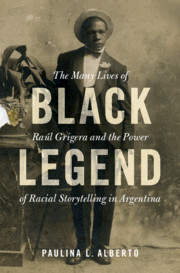Book contents
- Black Legend
- Black Legend
- Copyright page
- Dedication
- Contents
- Figures
- A Note on Terminology
- Introduction Racial Stories
- Chapter 1 Ancestors (1850–1880)
- Chapter 2 Community (1880–1900)
- Chapter 3 Youth (1900–1910)
- Chapter 4 Celebrity (1910–1916)
- Chapter 5 Defamation (1916–1930)
- Chapter 6 Deaths (1930–1955)
- Epilogue Afterlives (1955–Present)
- Acknowledgments
- Afro-Latin America
- Notes
- Bibliography
- Index
Chapter 6 - Deaths (1930–1955)
Published online by Cambridge University Press: 06 January 2022
- Black Legend
- Black Legend
- Copyright page
- Dedication
- Contents
- Figures
- A Note on Terminology
- Introduction Racial Stories
- Chapter 1 Ancestors (1850–1880)
- Chapter 2 Community (1880–1900)
- Chapter 3 Youth (1900–1910)
- Chapter 4 Celebrity (1910–1916)
- Chapter 5 Defamation (1916–1930)
- Chapter 6 Deaths (1930–1955)
- Epilogue Afterlives (1955–Present)
- Acknowledgments
- Afro-Latin America
- Notes
- Bibliography
- Index
Summary
Raúl’s decline and disappearance constitute the sadistic climax of the posthumous stories. Storytellers linger with relish over their accounts of his descent, after 1930, into poverty, illness, homelessness, alcoholism, police detention, and finally madness, institutionalization, and death. So enthusiastic are they about ushering Raúl to his end that they begin to declare him dying or dead decades before his actual demise in 1955. His death was permanently useful to tell and retell as part of a tragicomedy about the foolishness of persisting in being a Black person in a country that had outgrown them (or, in its great wisdom, had arranged never to have any). In this sense, storytellers merely conscripted Raúl into the broader narratives of always-impending (but never quite complete) Black disappearance that had circulated since his grandparents’ day. “Deaths” shows how the defamatory stories about Raúl’s decline and death, circulating since the 1930s in the press and popular culture, sped him to the sad ends storytellers envisioned for him. Between 1930 and 1955, Raúl’s trajectory as revealed by the archival record converges, in many important details, with the denigrating tales that took shape around him. But this chapter tells that story very differently. In part, Raúl’s difficulties in these years had to do with extensive transformations in Argentine society – economic depression, a military coup, intensified police repression, and the renewed vigor of eugenics and scientific racism. In part, too, his struggles reflected the fact that the journalists, photographers, police officers, physicians and psychologists who encountered Raúl during the last decades of his life were themselves informed by preexisting narratives about class, citizenship, and Blackness in Argentina. Using press coverage of Raúl, photographs, his police record, and his medical records from a hospital and two psychiatric institutions, I reconstruct these last decades of his life and demonstrate how they were deformed at every turn by narratives of Afro-Argentine death that were only strengthened, in storytellers’ eyes, by what they saw as Raúl’s sorry state. Finally, building on highly suggestive clues in his psychiatric file, the chapter closes with an alternative, or rather intersecting, re-reading of his life through the lens of queerness and same-sex sexuality.
Keywords
- Type
- Chapter
- Information
- Black LegendThe Many Lives of Raúl Grigera and the Power of Racial Storytelling in Argentina, pp. 276 - 339Publisher: Cambridge University PressPrint publication year: 2022



